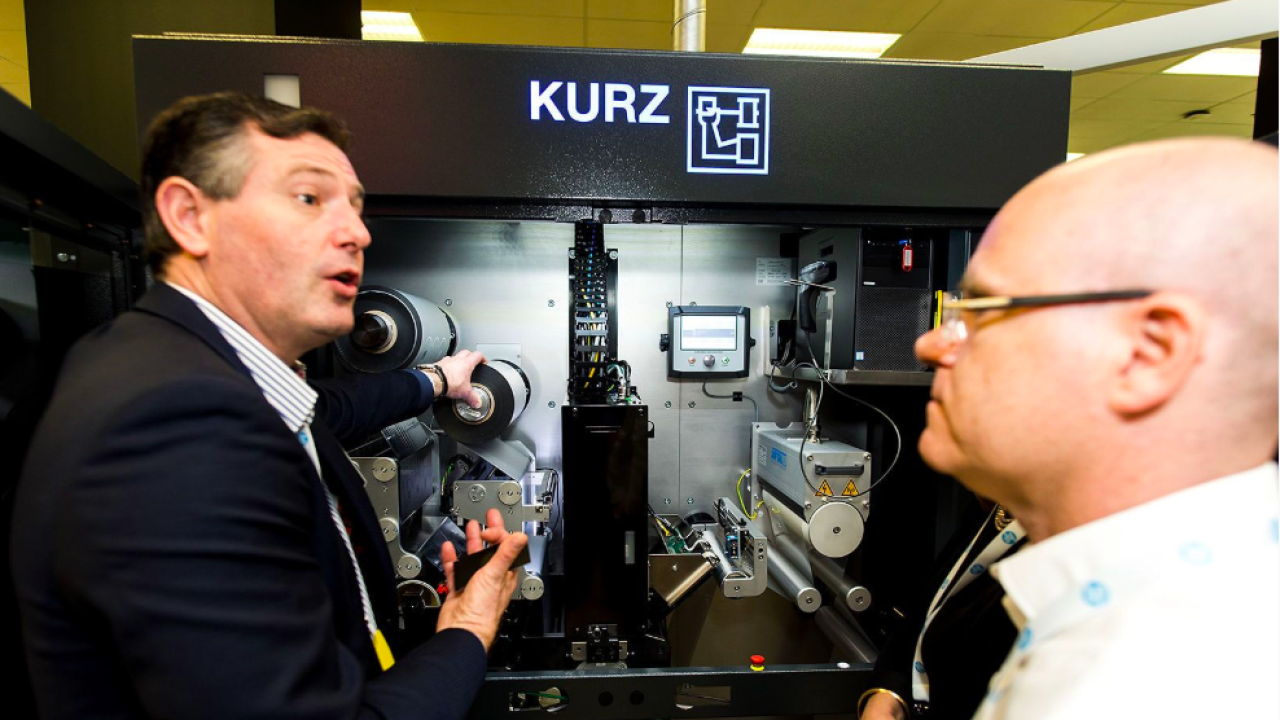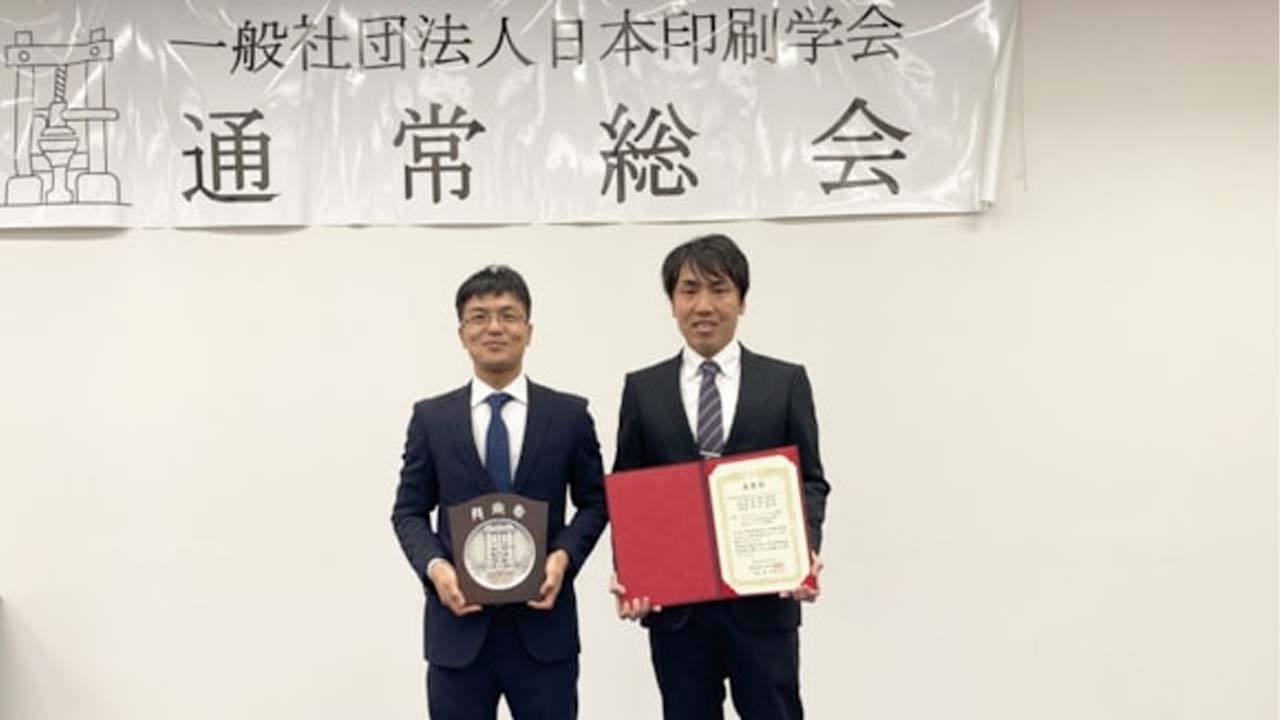HP event showcases digital advances

The Kurz DM-Liner module is integrated into the HP Indigo 6900 digital press. It sits, in-line, upstream of the press. The foil is laminated to the unprinted substrate using an inkjet-applied UV curing adhesive, with LED pinning to increase drop placement accuracy. A PET carrier is then removed and the substrate is transported to the 6900 for overprinting, producing full-color metallic effects, including variable print, in a single pass. The DM Liner’s production speed is up to 75m/min, which allows it to keep pace with the print engine, with a jetting resolution of 600 x 600 DPI on a 340mm web width.
The DM-Liner forms part of Kurz’s Digital Metal eco-system which includes a wide range of customized high gloss holographic, diffractive and silver foils.
The DM-Liner is now being beta-tested in Europe and will be launched officially at Labelexpo Europe in September.
Disrupting flexpack
The VIP event saw a series of presentations delivered by HP Indigo customers covering a wide range of end use applications.
ePac will be a name familiar to L&L readers. This disruptive, all-digital flexible packaging converter has been setting up plants across the US equipped with HP Indigo 20000 presses. CEO Jack Knott explained that the company is built on offering a maximum 10-day lead time from artwork to market with low minimum orders, compared with an industry standard lead time of 3-4 months. This has attracted customers right across the size range from $5m USD local brands to mid-sized $25m USD operations and global brands.
‘The globalization trend has meant consolidation and servicing only the biggest customers,’ explained Knott. ‘This means smaller customers cannot get their packaging to market in time, and this has become a major impediment to growth.’
Knott pointed out that millennial consumers looking for locally produced goods that match their lifestyle are driving the growth of smaller brands by up to 20 percent, a far higher rate than established brands.
‘We embed our plants directly into local communities and our customers can come directly to us,’ said Knott. ‘We don’t charge for plates or job setup and we print on demand instead of putting products in a warehouse and hoping they’ll get used.’
By the end of this year ePac expects to have 15 plants across the US, with each plant taking just nine days to build. The company expects to hit $61m USD revenue this year from a standing start of under $3m USD in January last year.
‘I traditionally built companies from the top down, which kills the innovation found in small to medium-sized businesses,’ said Knott. ‘The digital technology platform allowed us to turn this model on its head. We try not to hire people from the industry who say “you can’t do it this way”. The average age of our workforce is 25-26 and they bring their own entrepreneurial resources. Their job is to embed with their community and their customer base.’
Small equals agile
Rob Daniels, third generation owner of Quality Tape and Label (QTL), explained that this less-than $10m USD turnover converter is now 90 percent digital, using a combination of HP Indigo 20000, 6900 and 6800 machines. Around 84 percent of revenue in 2018 came from digital sales.
‘Twelve years ago we were fully flexo, but now flexo is a very small part of our business,’ said Daniels. The company has also diversified into filmic materials: ‘The ability to finish on a 30in width to order has been a real game changer for flexible packaging and shrink sleeves.’
Daniels admitted that for a company his size, moving up to the 20000 press in 2016 was a ‘big leap of faith’. But going to a wider format has paid off. ‘Shrink sleeves and flexible packaging will be our next big growth areas. Labels is still 75 percent of what we do. But in 2016 flexible packaging accounted for less than 1 percent of sales – last year it was 15 percent.’
To begin with shrink sleeves were sent out for finishing, but this soon moved in-house with the support of both HP and Karlville. Pouching remains outsourced.
Continued Daniels: ‘We have now run everything from aluminum foil and lidding film to folding cartons. What allows us to compete is changing the conversation with customers away from price to speed to market and lead time.’
The converter has made good use of HP Indigo’s recent specialist ink developments, including digital silver, premium white and Day-Glo fluorescents.
Daniels said variable data printing is ‘huge for us’. QTL was responsible for the world’s first Collage project with the King of Pops natural frozen treats brand. ‘Within eight business days of meeting HP, these wrappers were in store and sold out in a week. This demonstrates that price is not everything. This way you can get sticky with customers and they won’t leave you.’
Echoing Jack Knott, Daniels said that with digital print, revenue ‘is in the small and medium sized customers.’
Digital wins for brands
Monica Medina, packaging and design manager for Nestlé Mexico, delivered an excellent case study on marketing to millennials using a campaign which combined point of sale, digital label printing and e-commerce.
Nestlé claims more than an 80 percent share of the coffee market in Mexico, but had an image problem with millennials, who make up 29 percent of the population.
The ‘Nescafe Resolutions’ campaign was launched to bring the brand to life. The idea was to print the top 350 New Year resolutions of Mexican consumers onto 15 million jars. This was supported by TV adverts, posters on bus stops and a partnership with social networks. Mobile booths were set up where consumers could personalize labels and cups.
Consumers were encouraged to scan the digitally printed labels with a special app, leading to 20,000 interactions with the brand.
Danone is another end user which has revived established brands using digital print. Yves De Warrimont, sourcing manager, Printed Packaging Upstream at Danone, explained how the brand worked with HP Indigo for three years looking for new ways to innovate. A key challenge facing the global brands is the rise of the small local brand, now thought to account for over half of consumer spending.
‘The new trends are that small is big; consumers want everything now; there is a trend to healthier eating; and there are new on-line purchasing and marketing channels along with smaller format supermarkets. Millennials are playing a key driving role.’
Danone’s response was to ‘activate’ its brands using versioning, regional variation and links to events such as movies and sports. In terms of decoration this required new packaging formats and finishing effects to give a more premium feel.
Digital printing became a global focus for Danone in 2017. ‘We contacted HP Indigo at a global level to share knowledge throughout the company and with our print service providers, and within one year we did great things.’
One brand which particularly benefited was Aqua d’Or water, using HP’s SmartStream Mosaic software to create over 3 million unique label designs using variations on the geometric elements of earth and water, produced on HP 20000 presses. POD/POS elements were also used in the campaigns. Danone also made use of HP’s new Collage software to create a unique Holiday edition which went from original concept to launch in 2.5 months with 100,000 unique labels. ‘We are just scratching the surface,’ said De Warrimont.
This project illustrates the trend towards increasing SKUs and decreasing product life-cycles. ‘With digital we just print what we need, so it is sustainable. This reduces the cost of ownership to launch a product and speeds time to market, including fast prototyping.’
Technology highlights
HP’s VIP events showcase developments across the full range of end use applications from commercial print to labels, flexible packaging and cartons. Because all HP Indigo presses use the same basic LEP imagine technology, new developments can move quickly between press formats and end use markets.
ElectroInks: The event saw the introduction of HP Indigo ElectroInk Easy Release for scratch-off applications such as lottery cards and gaming applications. New launches in the security and brand protection space included Invisible Yellow and Blue ElectroInks, which are only visible under UV light.
Software: Following on from the success of its Mosaic ‘controlled randomization’ software, HP demonstrated SmartStream Collage, which manipulates set elements like logos and symbols in random patterns. Collage projects are taken to press via PrintOS Composer, a cloud-based processing platform.
Industry 4.0: HP introduced its Service Edge program, designed to introduce converters to the Industry 4.0-related concepts of automated workflows, predictive maintenance, assisted operator learning, data mining and machine learning, all targeted at optimizing business performance.
Automatic Alert Agent (AAA) is a new tool that scans every print and compares it to the original file, enabling automatic reprinting flagged jobs without reducing press speed.
PrintOS continues its development into an extensive modular workflow system. New modules launched at the event included PrintOS OEE (Overall Equipment Effectiveness), which helps uncover opportunities for improving operational efficiency, reducing overtime, and saving costs while increasing press utilization. PrintOS Color Beat is a module designed for automated color control.
Also announced at the event was the latest DFE version, HP SmartStream Production Pro 7.1, which supports these fully automated workflows and now includes a pixel-level viewer.
Stay up to date
Subscribe to the free Label News newsletter and receive the latest content every week. We'll never share your email address.


